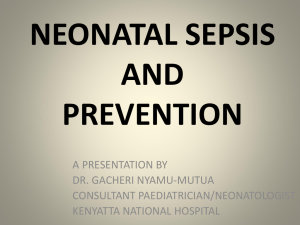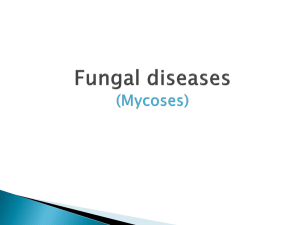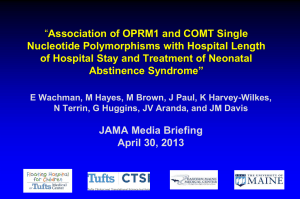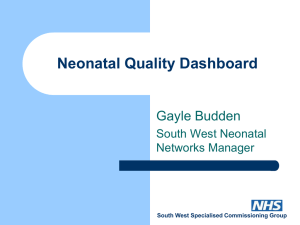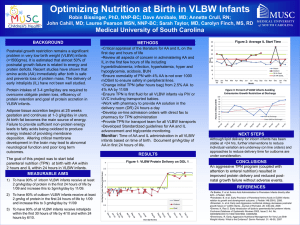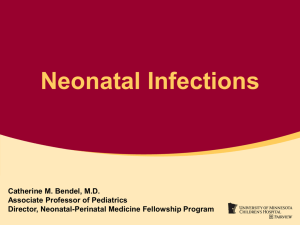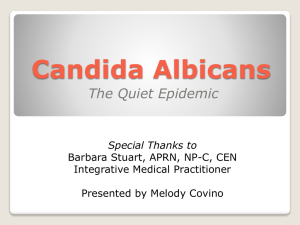Health Care Associated Infections on the NICU (aka Nosocomial
advertisement
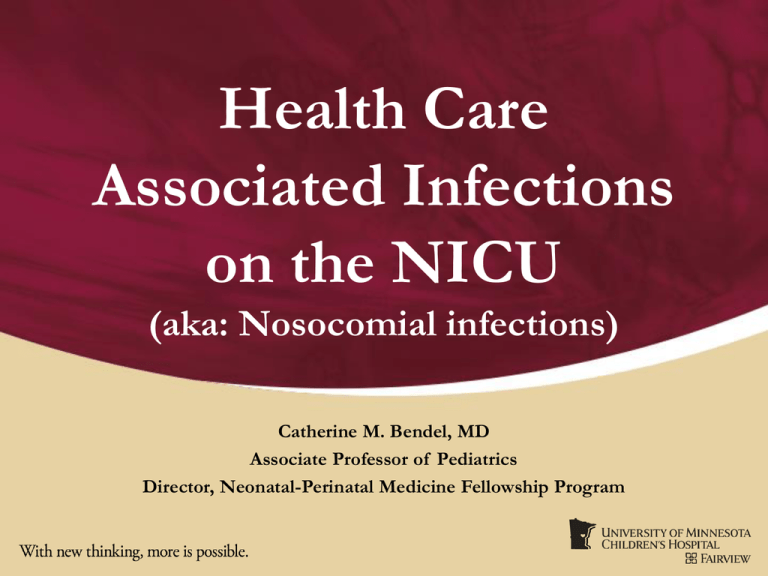
Health Care Associated Infections on the NICU (aka: Nosocomial infections) Catherine M. Bendel, MD Associate Professor of Pediatrics Director, Neonatal-Perinatal Medicine Fellowship Program Objectives • Define and differentiate between early-onset, late-onset and health-care associated (nosocomial) infections on the NICU. • List the major micro-organisms responsible for each of these types of infection. • Understand the risk factors for NICU nosocomial infections. • Understand what laboratory tests are important in making the diagnosis of each of these infections. • Understand the primary prevention strategies “Prematurity is an infectious disease.” - James Todd, M.D. Definitions • Early Onset Neonatal Sepsis (EONS) • Late Onset Neonatal Sepsis (LONS) • Nosocomial or Health Care Associated Neonatal Infections (HCANI) <5 days old (prenatal or peripartum) 5 days to 3 months old (peripartum) Any infection that develops while a patient is in the hospital (peripartum or postnatal) Bacterial/ Viral/ Fungal Microbes • Early Onset Neonatal Sepsis (EONS) • Late Onset Neonatal Sepsis (LONS) • Nosocomial or Health Care Associated Neonatal Infections (HCANI) Maternal normal GU flora (GBS/ E. coli) Maternal flora and pathogens (GBS/Chlamydia/MRSA/HSV/HepB / CMV/ HIV/Candida….) Skin/GI/Resp - self/others/equipment (CoNS/ gram negs/Candida/RSV) Microbes - HCANI • #1 Coagulase-negative Staphylococcus • Infant skin or GI tract • Care-provider hands • #2 Gram-negative bacilli • Infant skin, respiratory or GI tract • Care-provider hands (artificial nails) • Medical equipment • #3 Candida spp (C. albicans, C. parapsilosis, C. glabrata) • Infant skin or GI tract • Care-provider hands • Medical equipment/treatments Incidence • Early Onset Neonatal Sepsis (EONS) • Late Onset Neonatal Sepsis (LONS) • Nosocomial or Health Care Associated Neonatal Infections (HCANI) 1-10/1,000 live births 15-25/1000 premies 0.5/1,000 live births (GBS) ~5% of all NICU admissions 11-32% of all VLBW (<1500) Why are infants, especially premies, more susceptible to infections? Risk Factors for HCANI: Intrinsic • Prematurity – ELBW > VLBW • • • • Immunology of the neonate Mechanical barrier to infection Severity of illness Abnormal microbial flora Prematurity • Risk of infection inversely related to BW/GA • VO study looking only at bacterial sepsis: – – – – 26% if 501-750 grams 22% if 751-1000 grams 15% if 1001-1250 grams 8% if 1251-1500 grams • Most likely a surrogate marker for immunologic immaturity, immature barrier function and severity of illness Neonatal Immune System • All neonates relatively immunocompromised • Immature, Ineffective and Inadequate levels: – Antibodies / complement – Neutrophils – T-cells / cytokines Antibodies Infectious agent Immunity Figure 1.1 Antibodies (anti- foreign bodies) are produced by host while cells on contact with the invading micro-organism which is acting as an antigen (e.g. generates antibodies). The individual may then be immune to further attacks. (Modified From: Roitt, I: Essential Immunology, 4th edition, Blackwell Scientific Publications, 1980) Antibodies Infectious agent x x Immunity No contact with infectious agents = no antibody production Life in-utero Premature Antibody levels • Extremely low production, reduced opsonic activity • Primary source - active placental transfer of maternal antibodies • Most maternal antibody transferred in the 3rd trimester • Maternal antibody concentrations low for 1o pathogens So smaller and earlier = lowest levels and least effective antibody Remington and Klein, Sixth Edition, 2006 Neonatal Neutrophils (PMNs) • Immature – – – – Chemotaxis Deformability Phagocytosis Storage pool • Adults 14-fold > circulating pool • Neonates only 2-fold Manroe et al, J Pediatr, 1979 7500 3600 ANC = absolute neutrophil count Mouzinho et al, Pediatr 94:76, 1994 “Normal” VLBW neonates Mouzinho et al, Pediatr 94:76, 1994 6000 1200 30 days “Normal” VLBW neonates (<1200 abnormal) Neonatal Neutropenia • • • • Prematurity Maternal Hypertension IUGR Sepsis Neonatal Barriers to Infection Impairments/alterations in Neonatal Natural Barriers • Immature Skin – Thin, lacking multiple layers/keritin – Easily damaged by • Drying (phototherapy/open warmer) • Adhesive tape/ monitor leads • Handling / phlebotomy/ surgery – Surgical wounds heal more slowly Invasive Fungal Dermatitis in a VLBW infant QuickTime™ and a TIFF (Uncompressed) decompressor are needed to see this picture. JL Rowen, Sem Perinatal 27:406-413, 2003 QuickTime™ and a TIFF (Uncompressed) decompressor are needed to see this picture. Impairments/alterations in Neonatal Natural Barriers • Umbilicus - colonization of devitalized tissue • GI tract – Increased gastric pH with drip feeds/H2 blockers – Mucosal damage with NEC Severity of Illness • Direct correlation with rate of HCANI: – Increased LOS – Higher severity of illness scores – Congenital anomalies • Potential correlation: – Prenatal insults/stress Abnormal Microbial Flora • Altered maternal transmission of normal flora due to C/S, prenatal antibiotics, etc • Altered neonatal colonization due to – Broad-spectrum antibiotics (favors Candida) – Delayed enteral feeds Risk Factors for HCANI: Extrinsic • Catheters – UAC, UVC, PICC, ETT, Foley, CT, Peritoneal drains, etc • Hyperalimentation / intralipids • Medications • Understaffing / overcrowding • Care-giver to patient transmission of flora/pathogens Central Venous/Arterial Catheters • • • • • Life-saving tools on the NICU Necessary evil Stasis, thrombin formation Hyperal /IL Length between tubing changes – 72 hours significantly higher risk than <24 hours Central Venous/Arterial Catheters • Skin bugs colonize the hub or exit-site, migrate up the catheter and enter the bloodstream or infect a clot at the tip – UVC > PICC / Broviac – UAC > perc A-line • Transient bacteremia results in tip infection (GI) • Increased incidence of infection with time UVC > UAC > PICC / Broviac • Minimally at 7 days • Significantly at 10-14 days or if clot present Catheters • Micro-organisms love to stick to plastic • ANY CATHETER IS AT RISK!! • ETT, Foley, CT, Peritoneal drains, etc Hyperalimentation / Intralipids • Associated with increased risk of CoNS, Candida spp and Malassezia spp • Exact etiology unclear – Inhibition of IL-2 and lymphocytes – Hyperglycemia – Sugar and fat source that promotes growth of select microbes – Affects of delayed enteral nutrition on GI flora/anatomy Medications • Broad spectrum antibiotics – Alter normal flora (>5 days increases risk of candidemia) – Select for resistant microbes -- super bugs! • Third generation cephalosporins (Cefotaxime) – Emergence of beta-lactamase producing Klebseilla pneumoniae • Vancomycin - VRE Antibiotic-resistant microbes • Vancomycin- resistant enterococcus (VRE) – Theoretic risk on NICU – risk with multiple course of vanco – Strict contact isolation • Methicillin-resistant Staphylococcus aureus (MRSA) – Real risk on NICU – Community / maternal acquired – Vanco use required – Strict contact isolation Medications • H2- blockers (ranitidine/Zantac) associated with increased bacterial and fungal infections • Steroids • • • • Immunosuppression Hyperglycemia Skin compromise fragility Poor healing • Topical petrolatum ointment (aquaphor) associated with increased fungal infections Incidence of Systemic Candidiasis associated with TPO in infants with BW ≤ 1500 grams Campbell JR, Zaccaria E, & Baker CJ, Pediatrics 2000;105:1041-1045. Understaffing and Overcrowding • Understaffing / increase in census associated with – Decreased handwashing – Epidemics of • • • • • Staphylococcus aureus MRSA Multi-drug resistant Enterobacter cloacae Multi-drug resistant K. pneumoniae Candida albicans Care-giver to patient transmission of flora/pathogens • Hands of healthcare workers (HCW) a reservoir for pathogens - controlled with adequate hand washing • Persistent organisms on HCW hands due to: – – – – Omitting or inadequate handwashing Contaminated antimicrobial washes Persistent organisms not addressed with antiseptic: Candida Artificial, painted and long natural nails, hand jewelry associated with infectious outbreaks Health care associated infections on the NICU: Presentation and Diagnosis Neonatal Infections Sepsis Meningitis Pneumonia NEC/perforation candidemia EONS NEC UTI Osteomyelitis Suppurative Arthritis Conjunctivitis Orbital Cellulitis Cellulitis - - Omphalitis Otitis Media Diarrheal Disease Bacterial / Viral / Fungal HCANI -Any & All Multi-organ Signs/Symptoms ? Laboratory Evaluation • Cultures • Complete Blood Cell Count • CSF glu, protein, WBC • Glucose • Bilirubin • Liver Function Tests • Coagulation studies • C-reactive Protein (CRP) • • • • • Chest Radiograph Abdominal X-ray Cardiac ultrasound Catheter ultrasound Renal ultrasound (fungal balls) • Ophthalmologic exam • Head ultrasound/ CT New order-set in FCIS! Cultures -- Who and Which? • Blood culture -- indicated in ALL infants with suspected sepsis. Repeat cultures indicated if initial culture positive. • ETT culture (with gram stain)-- indicated in all intubated patients • Urine culture -- more helpful in LONS/HCANI – + in 1.6% EONS compared to 7.47% LONS Klein, Sem in Perinat, 5:3-8 Cultures -- Who and Which? • CSF culture -- should always be considered Meningitis frequently accompanies sepsis - Infants do not localize infections well - 50-85% meningitis cases have + blood culture - Specific signs & symptoms occur in less than 50% of infants with meningitis - Using “selective criteria” for obtaining CSF may result in missed or delayed diagnosis in up to 37% of infants with meningitis Wiswell et al, Pediatrics, 1995 Laboratory Diagnosis of Neonatal Meningitis CSF -- > 32 WBC/mm3 > 60% PMN glucose < 50% - 75% of serum protein > 150 mg/dl organisms on gram stain Complete Blood Cell Counts • Is the CBC helpful as an indicator of nosocomial neonatal sepsis? – Thrombocytopenia frequently associated with sepsis – WBC may be high, low or “normal” – Persistent low WBC more predictive of sepsis than elevated WBC (ANC < 1200) – I:T quotient unreliable C-Reactive Protein • Elevated CRP, > 10 mg/L (>1 mg/dl), highly associated with sepsis --- but NOT diagnostic • Limited by lack of “normal” reference values for preterm infants • Normal CRP in “rule-out NEC” evaluation correlates with absence of infection • Trend with multiple samplings correlates with persistence (CRP) or resolution (CRP) of infection • May be useful tool in determining the endpoint for antibiotics C-Reactive Protein Pediatrics, 1997, 99:216-221 C-Reactive Protein • CRP levels <10mg/L, determined >24 hours after beginning therapy correctly identified 99% of infants not needing further therapy. • CRP-guided determination of length of therapy, shortened the treatment course for most infected infants without increasing the rate of relapse. • Limitations: no studies evaluating meningitis or infections other than bacterial sepsis. Specific Signs/Symptoms • NEC - risk of CoNS • GI perforation - risk of Candida /GI organisms/ anaerobes • Liver Dysfunction - risk of virus • Respiratory decompensation - risk GI bugs or respiratory virus (influenza, RSV-especially with apnea) • Renal insufficiency - risk of Candida • CNS involvement - anything • Thrombocytopenia - risk of Candida / HSV/ CMV Empiric Therapy • Vancomycin IV - gram positive coverage treats CoNS, MRSA, GBS, Group D enterococcus • Cefotaxime IV - gram negative coverage treats Klebsiella spp, E.coli • Tailor therapy when culture results known Additional Empiric Therapy • Add – Clindamycin when risk of anaerobes (GI perforation) – Acyclovir when risk of HSV – Amphotericin when risk of Candida Yeast Susceptibilities Fairview-University Medical Center – 2006 C a ndi da C a ndi da C a ndi da C a ndi da C a n di da a lbi ca n s g la brata k ru sei tro pica lis p ar a psil osis A m pho B 9 9% 9 9% 5 -F C 9 9% 9 8% 0% 9 3% 9 9% Fl ucon- 9 8% 5 0% O% 7 8% 9 6% 9 7% 5 1% 6 7% 8 0% 1 00 % a zo le Itra co na zo le 1 00 % 1 00 % 1 00 % Health care associated infections on the NICU: Prevention!!!!! Strategies for prevention: Eliminate/reduce risk factors - intrinsic – Prematurity - not likely/beyond our control – Low IgG - IVIG not successful – Low ANC - Granulocyte stimulating factor (GCSF) moderate success – Immature skin - Aquaphor not successful, use extreme care with adhesives/handling – Severity of illness - ???? Strategies for prevention: Eliminate/reduce risk factors - extrinsic Catheters • Insert only when indicated/remove promptly when no longer required • Utilize protocols for sterile insertion and maintenance (chlorhexidine, transparent dressings, etc) • Minimize manipulations • Remove if evidence of infection or clot formation • Replace UVC/UAC when required > 10-14 days – PICC / broviac / percutaneous a-line Strategies for prevention: Eliminate/reduce risk factors - extrinsic Antibiotics • Judicious use • Avoid prolonged courses of BSA • Avoid prolonged and frequent courses of 3rd generation cephalosporins or vancomycin • Nystatin prophylaxis - prevents fungal overgrowth Strategies for prevention: Eliminate/reduce risk factors - extrinsic Hyperalimentation • Advance enteral feeds as rapidly as possible • Minimize handling/breaks in line Medications • Avoid rantidine (zantac) • Avoid/shorten courses of steroids • Avoid topical petrolatum Strategies for prevention: Eliminate/reduce risk factors - extrinsic #1 Preventative Measure: GOOD HAND-WASHING!!!!! Miscellaneous Human papillomavirus (HPV) • • • • • HPV causes both common skin warts (benign) and cervical/vaginal warts in the female (precursor to cervical dysplasia/cancer) Generally asymptomatic Infection can be passed to the infant during vaginal delivery Symptoms usually occur between 2-5 years of age – Respiratory tract – Mouth – Eye Difficult to treat -- vaccine might prevent Respiratory Syncytial Virus (RSV) • Causes an acute respiratory illness • Infants prone to severe bronchiolitis and apnea, often requiring hospitalization with ventilation • Preterm infants at high risk for complications • May be associated with the development of asthma as an older child • Transmission is by direct or close contact with contaminated secretions • Good handwashing best prevention • Virus can live on environmental surfaces for hours Respiratory Syncytial Virus (RSV) • Diagnosis – Classic symptoms - respiratory with apnea – Culture or rapid test on nasopharyngeal swab • Treatment – Symptomatic – Supplemental oxygen or respiratory support • Prevention – Palivizumab (Synagis) - monoclonal antibody – Passive immunization - monthly injections during RSV season (roughly Nov - March) Indications for Synagis • Infants <24 mo with chronic lung disease who have required therapy within the last 6 months • Infants <24 months with hemodynamically significant heart disease • Infants born <32 weeks GA – <28 weeks GA up to 12 mo – 28-32 weeks GA up to 6 mo AAP Redbook, 2006 Report of the Committee on Infectious Diseases Indications for Synagis • Infants 32 - 35 weeks GA with risk factors – – – – – Child-care attendance School-age siblings Exposure to environmental air pollutants Congenital abnormalities of the airway Infants with severe neuromuscular disorders • Synagis is not indicated for the treatment of RSV disease AAP Redbook, 2006 Report of the Committee on Infectious Diseases Candida Treatment — Parenteral • Amphotericin B - mainstay of therapy • Daily dosage: • No “test dose” required in neonates • Initial dose 0.5 mg/kg IV over 2-6 hours • Increase by 0.25 mg/kg/d to goal of 1.0mg/kg/d • Adjust for renal insufficiency 0.75- Candida Treatment — Ampho B • Treatment Course • 10-14 days for uncomplicated line sepsis • 3- 6 weeks for disseminated or complicated sepsis. Cumulative dose of 30-35 mg/kg or clearance of disease — whichever comes first! • Monitor systemic involvement for improvement/clearance — serial ultrasounds, repeat cx, etc. Candida Treatment — Ampho B • Complications of therapy: • Renal insufficiency • Monitor UOP, BUN,Cr qod initially; then q week if stable • Renal failure reversible, but dialysis may be required • Profound hypokalemia / hypomagnesemia • Monitor K and Mg levels closely • Hematologic - bone marrow suppression • Monitor CBC and platelets qod initially and then q week • Liver dysfunction Candida Treatment — Alternatives • Liposomal Amphotericin B (Ambisome) or Amphotericin B Lipid Complex (Ablecet) or Amphotericin B colloidal dispersion • Dosing: 3-5 mg/kg/day IV over 2hours • Appears to be safe and effective, but not superior to conventional Ampho B • Diminished side effects, especially renal • Limitations: • Decreased renal absorption Candida Treatment — Alternatives • Fluconazole — IV (vorconazole next generation) • Dosing, over 2-6 hours: • Preterm ≤ 29 weeks: 5-6 mg/kg/72 hours • Preterm 30-36 weeks: 3-6 mg/kg/48 hours • Term: 6-12 mg/kg/24-72 hours • Monitor levels • Side effects: renal, hepatic and hematologic, but less than Ampho B Complement Risk Factors #1 PREMATURITY ELBW > VLBW Risk Factors for Neonatal Nosocomial Infections • Prematurity – ELBW > VLBW • • • • • Increased LOS Abdominal surgery / NEC Hyperalimentation / Intralipids Neutropenia, Thrombocytopenia Catheters – UAC, UVC, ETT, Foley, CT, Peritoneal drains, etc Risk Factors for Neonatal Nosocomial Infections • Prematurity – ELBW > VLBW • • • • • Increased LOS Abdominal surgery / NEC Hyperalimentation / Intralipids Neutropenia, Thrombocytopenia Catheters – UAC, UVC, ETT, Foley, CT, Peritoneal drains, etc Antibody Neutrophils Signs/Symptoms Strongly suggestive hypoglycemia / hyperglycemia hypotension metabolic acidosis apnea shock DIC hepatosplenomegaly bulging fontanelle seizures petechiae hematochezia respiratory distress Signs/Symptoms Nonspecific lethargy, irritability temperature instability -- hypothermia or fever poor feeding cyanosis tachycardia abdominal distention jaundice tachypnea
